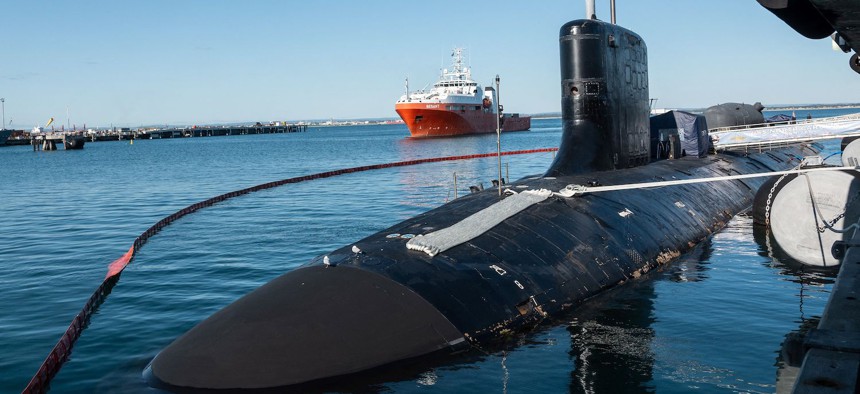
A U.S. Navy Virginia-class submarine, USS North Carolina, docks at the HMAS Stirling port in Rockingham on the outskirts of Perth, Australia, on August 4, 2023. TONY MCDONOUGH / AFP via Getty Images
The race is on to prepare Australia for nuclear subs
“There has been a hiatus where we weren’t all paying attention. Now we’ve got to catch up,” a UK shipbuilding exec says.
HONOLULU, Hawaii—The first American rotational-force submarine is slated to arrive in Australia in about 36 months, and the nation will have its first sovereign submarine in roughly 100 months. That doesn’t leave a lot of time for the “enormous amount” of prep work, one UK shipbuilding executive said.
There is “an awful lot to do in a relatively short period of time,” said Nick Hine, a former second-in-command of the Royal Navy who is today the managing director of AUKUS and international for British defense company Babcock.
“You’re going to have to establish in Australia a regulatory system, a safety system, a whole bunch of new security issues for nuclear,” Hine told Defense One at last week’s Pacific Forum event here. “You need a social license conversation that hasn't been heard before in Australia. You need a skilled workforce, of which there are thousands of people needed at various levels, from nuclear PhDs to people who can drive cranes—because driving a crane near a nuclear submarine is different to driving a crane but not near a nuclear submarine, for all the reasons you would understand.
“Then there's a whole bunch of infrastructure that needs to be designed, delivered, tested, and produced,” in addition to training, software, supply chain establishment, and more, he said.
All that has emerged in the wake of the September 2021 announcement of the AUKUS defense-technology pact between the United States, the United Kingdom, and Australia. The agreement includes plans for Australia to host nuclear submarines from the U.S. and UK, to buy at least three Virginia-class submarines from U.S. shipbuilders, and to eventually take delivery of SSN-AUKUS submarines designed jointly by the U.S. and UK.
Hine said the timeline for those developments is “relatively imminent”: 2027 for the first rotational force visit, 2032 for Australia’s first Virginia-class submarine, and 2042 for the SSN-AUKUS.
Earlier this month, the first three Royal Australian Navy officers graduated from the U.S. Navy’s Nuclear Power Training Unit in Charleston, S.C. Their next stop is Submarine Officer Basic Course in Groton, Connecticut. But Hine noted that a Virginia-class submarine has a crew of 135—not to mention the support and maintenance personnel, all of whom need not just training, but experience.
A program is already in place to embed Australian submariners in U.S. and UK subs to gain that crucial experience. As well, Babcock and U.S.-based HII have established an AUKUS Workforce Alliance in Australia to foster skills up to the graduate level at three Australian universities. Hine said the Babcock and HII will also launch a company, H&B Limited, that will be sovereign to Australia but able to reach back to the two companies with more than 100 years of submarine experience between them.
The AUKUS agreement comes at a critical time, Hine said, when more nuclear submarines are needed in the Indo-Pacific—“the sooner the better.”
“AUKUS is about lots of things. It’s about increasing industrial capacity across three nations. It’s about delivering more nuclear submarines to the Indo-Pacific. It’s about a whole bunch of advanced technologies in pillar two that need to be developed. Because effectively, there has been a hiatus where we weren’t all paying attention. Now we’ve got to catch up,” Hine said.
“If it was me…as you disperse your nuclear submarine fleet across the Pacific, you have some in Guam, you have some in Australia, you have some in Pearl Harbor, you have some potentially in Yokosuka, you have you have submarines in different places, you have the ability to support new submarines in different places,” the retired vice admiral said. “You should be able to move your submarine forces around the Indo-Pacific seamlessly, and get the same level of services with the same…qualified people in any one of these places. That’s what makes you a truly globally interchangeable force.”




